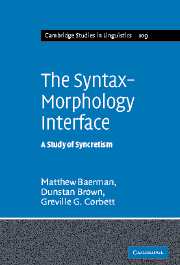Book contents
- Frontmatter
- Contents
- Preface
- List of abbreviations and symbols
- 1 Introduction
- 2 Characteristics of syncretism
- 3 Cross-linguistic typology of features
- 4 Formal representation
- 5 Formal framework and case studies
- 6 Conclusion
- Appendix 1 Case syncretism in the World Atlas of Language Structures sample
- Appendix 2 Person syncretism in the World Atlas of Language Structures sample
- Appendix 3 Syncretism in two-place verbs in the World Atlas of Language Structures corpus
- Appendix 4 DATR fragment for Dhasaanac case study
- Appendix 5 DATR fragment for Dalabon case study
- Appendix 6 DATR fragment for Russian case study
- References
- Author index
- Language index
- Subject index
5 - Formal framework and case studies
Published online by Cambridge University Press: 22 September 2009
- Frontmatter
- Contents
- Preface
- List of abbreviations and symbols
- 1 Introduction
- 2 Characteristics of syncretism
- 3 Cross-linguistic typology of features
- 4 Formal representation
- 5 Formal framework and case studies
- 6 Conclusion
- Appendix 1 Case syncretism in the World Atlas of Language Structures sample
- Appendix 2 Person syncretism in the World Atlas of Language Structures sample
- Appendix 3 Syncretism in two-place verbs in the World Atlas of Language Structures corpus
- Appendix 4 DATR fragment for Dhasaanac case study
- Appendix 5 DATR fragment for Dalabon case study
- Appendix 6 DATR fragment for Russian case study
- References
- Author index
- Language index
- Subject index
Summary
As we saw in the previous chapter, the challenge for a formal analysis of syncretism is twofold: to represent the cross-linguistically more general patterns of syncretism in terms of feature structure, and to account for patterns which occur independently of feature structure. In this chapter we lay out a formal framework and demonstrate it with three cases studies. When introducing the formal framework, we show in §5.1 that inferential-realizational frameworks, such as Network Morphology and Paradigm Function Morphology, are capable of capturing syncretic patterns which may arise as the result of underspecification, or as the result of referrals (i.e. independently of feature structure). One advantage of such approaches is that referrals and underspecification can be used simultaneously. We shall see when we come to the second case study that this is just what is required for the avoidance morphology of Dalabon. Indeed, we show that generalized referrals – where sets of paradigm cells can refer to sets of paradigm cells – which frameworks such as Network Morphology allow for, are an important requirement.
We consider the relationship between underspecification (a feature structure-based constraint) and semantic naturalness. As we saw in Chapter 4: §4.2.1, underspecification can be used with atomic feature values (i.e. in a ‘flat’ structure) where the syncretism is the default to the ‘elsewhere’. In such cases, in the absence of other representational means, only one syncretic pattern can be described for any domain.
Information
- Type
- Chapter
- Information
- The Syntax-Morphology InterfaceA Study of Syncretism, pp. 171 - 218Publisher: Cambridge University PressPrint publication year: 2005
